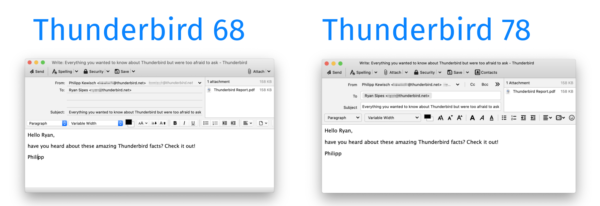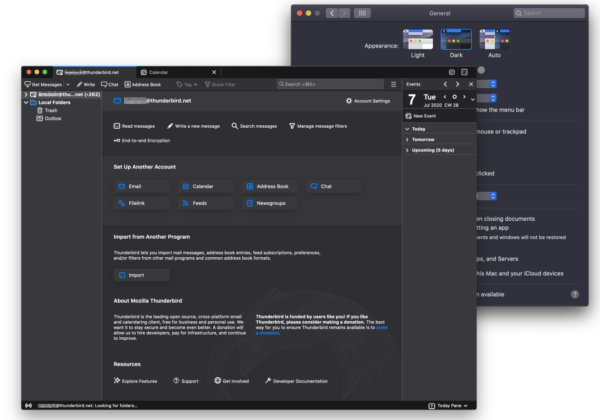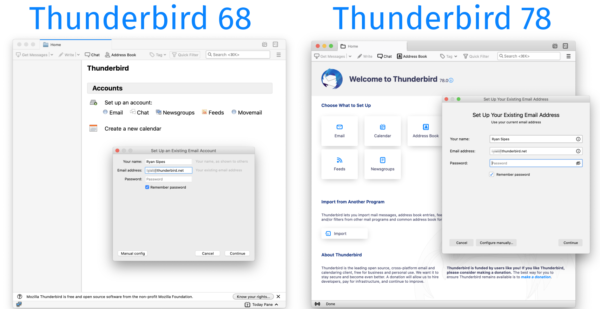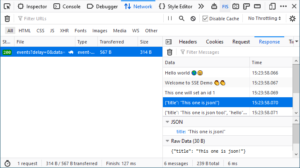Rolandt
Shared posts
Brexit gets more real, Brexiters get more unrealistic
The Border Operating Model
Much of this will apply whether that period ends with a trade deal or not (i.e. ‘no deal 2.0’). Given that, one might ask why it is only now, with less than six months to go, that these preparations are being communicated and in some cases being developed. For example, the £705 million border investment just announced was going to be needed anyway, as was the huge lorry park in Kent for which land has only just been purchased (it will be one of over ten similar sites). Moreover, despite Boris Johnson’s bluster and lies, it has been known for months that new processes, which were announced this week with the Border Operating Model, were going to be needed not just for UK-EU trade but for goods moving from Great Britain to Northern Ireland yet the facilities for this are only now beginning to be developed.
After all, it has been UK policy to leave both the customs union and the single market since January 2017. To have left matters so late is not just incompetence but, very likely, reflects the refusal to understand or accept that the result of that policy was necessarily going to entail increased border friction. That is politically significant because, recalling the circumstances of 2017-2019, it is at least conceivable that had the government admitted this, rather than pretending that a “frictionless” trade deal was possible, the closely-fought battle over a second referendum would have gone the other way.
Not only is it very late in the day, with significant doubts as to whether either the government IT systems or businesses will be ready in time, but also the new Border Operating Model is still very far from providing all the information that businesses will need in order to comply. For small trading businesses, in particular, this is an impossible situation in itself. Worse, as the full complexity and costs (£) become known some, at least, will simply cease to be viable, especially coming during the ongoing pandemic crisis. For those, large and small, that do continue these new costs will have to be absorbed in some way or passed on to customers.
The cost of customs
These costs – just as regards customs declarations, before any other costs are considered – will amount to £7 billion a year (£) to UK businesses trading with the EU, rising to £13 billion (£) when EU businesses trading with the UK are included. It’s worth reflecting on these figures. They compare to the approximately £9 billion net contribution the UK made to the EU in 2018. It’s not a one-off, but a recurring annual cost. And, to repeat, it exists whether or not there is a trade deal – it is nothing to do with any tariffs that may be levied or any other trade barriers that may arise.
The slogan for the information campaign is ‘Let’s Get Going’, which some businesses might reasonably take as a suggestion to relocate abroad while there’s still time. Individuals might take it as cue to go on holiday but if so they, too, need to be quick as they are now having it spelled out in more detail what Brexit will mean for them when they travel to the EU in terms of new border controls, health insurance, and pet passports.
For those who have been paying attention, none of this will be a shock – although seeing the practical details of what it means may still be a surprise. For others, it may be puzzling. For they were told before the Referendum and ever since that such Brexit effects were just Project Fear, then that Brexit had been done on 31 January with no obvious changes, and throughout that a deal would be negotiated which – although the ‘exact same terms’ lie has been long ago dropped – by implication would mean things pretty much carrying on as normal.
In fact, many of the things that remainers have long warned about are set to happen. Perhaps this is why the government resolutely refuse to describe them as being about Brexit (£) but, instead, as “the UK’s new start”, a new start which is said to bring ‘exciting opportunities’. What these are has not been specified and there is a reason for that, too: there are no exciting opportunities. It’s simply a self-inflicted change for the worse. A new start, perhaps, but the start of new barriers to trade and travel, new costs, new regulations and new bureaucracy resulting from leaving both the single market and the customs union. To coin a phrase, “only a madman would actually leave the market”. Britain is that madman.
What new madness is this?
The speaker of those words was, of course, Owen Paterson MP (whose explanation of the ‘madman’ comment is here; apparently ‘leaving the market’ and ‘leaving the single market’ are different things, so now you know) who has cropped up again this week, being listed as one of the contributing authors of a new report by the Centre for Brexit Policy (of which he is also the Chairman). Entitled ‘Replacing the Withdrawal Agreement’, this is being widely publicized, with coverage in the Daily Telegraph (£) and of course The Express, and a write-up by the Centre’s Director-General, John Longworth, on the Politico website. So it has the look of a concerted campaign.
The report itself, as its title suggests, propounds the extraordinary idea that the government should unilaterally create a new ‘Sovereignty Compliant Agreement’ to replace the WA and present it to the EU. If they do not agree, the UK would no longer regard itself as being bound by the WA. The report lists many ways in which the WA is not ‘sovereignty compliant’, including the Northern Ireland Protocol, and within that the role of the ECJ, as well as the ECJ’s role with respect to Citizens’ Rights and other matters, and the size – and by implication even the existence - of the financial settlement. Contained within all this seems to be a bemusement that the terms of the WA hold whether or not there is a trade deal. The authors – and David Davis in a tweet endorsing them – seem to imagine that the withdrawal terms were contingent on the trade deal, reprising the ‘row of the summer’ of 2017 that Davis famously threatened and then lost (or didn’t fight) which has rankled with the Ultras ever since.
It’s important to be clear – and the report is – that this isn’t about questioning this or that detail within the WA, it is that “the entire WA and Protocol are incompatible with UK sovereignty” (p.7). They want to revisit every single part of the Article 50 negotiations. But those negotiations are over. Unsurprisingly, a European Commission spokesperson immediately ruled out a renegotiation. The Longworth article gives full rein to the sentiments underlying this proposal: they are that the entire WA is a “poison pill” deriving from May’s lack of belief in Brexit, and the way her “government worked hand-in-glove with Remain elements of the British establishment and in cahoots with Brussels and foreign powers”. So Britain remains in “Teutonic chains” paying “reparations” and faces (yawn) a “Dunkirk” moment. It is a spectacularly vicious piece of writing.
Re-writing history
There are some very obvious problems with this proposal – even leaving aside the legal issues involved in breaking the WA - which involves a substantial re-writing of history. The UK signed the WA less than six months ago, as an international treaty. It was signed by Boris Johnson, following his much-trumpeted re-negotiation, and was put to the electorate as the ‘oven ready deal’ which was the centre piece of his re-election. At that election, the Brexit Party initially threatened to run a candidate in every seat if Johnson didn’t scrap the WA but then withdrew that demand and did not field candidates in Tory-held seats. John Longworth, then a Brexit Party MEP (he was later expelled from it), welcomed this change of strategy (£) on the grounds that “the Government’s exit agreement is Brexit and, whilst it has drawbacks, could result in a good deal”. No talk of a “poison pill” then. The Brexit Party itself garnered 2% of the vote and did not win any seats.
Thereafter, the WA Act was passed by a large majority in the House of Commons with support from ERG MPs, including Paterson. Did they not want the British Parliament to make its own decisions? It may be that some MPs did not read or understand it: if so, tough. They should have done their job properly. It may be that they believed it was all up for re-negotiation in the future: if so, tough. They were wrong. As for Longworth, as a, by then, Conservative MEP he also voted (in the European Parliament) for the WA and at the time said that as a result we will leave the EU and “become once again an independent, sovereign nation”. Now he says it was drawn up by “fools or knaves” and is incompatible with being “a truly sovereign nation”.
The proposition that Johnson had no time to re-negotiate properly is nonsense both because the time frames were of his choice and because he himself declared it to be “a great new deal” and the Conservative Party manifesto for the 2019 election also described it as such. The Conservative Party website explicitly said that those who criticized it (in context, this presumably meant Farage) were wrong and that the deal did indeed “take back control”. And even – to be far more charitable than is warranted – if none of that were true, it’s simply absurd to think that any country can conduct itself in such a manner as to rip up major international agreements within months of signing them because it hadn’t created an adequate process to consider the commitments it was making.
The Ultras have never accepted the WA
The roots of this latest outburst from the Brexit Ultras go deep, as regular readers of this blog will know. Immediately after the 2019 election I wrote:
“I suspect that many in the ERG will now be thinking that Johnson’s deal was only the bastard offspring of May’s ill-fated premiership and the ‘remainer parliament’, and feel no allegiance to it. They kept quiet during the election campaign, which required them to pledge support for Johnson’s deal, but that won’t necessarily last. For one thing, many of them are rebels by temperament, with a track record going back in some cases to John Major’s premiership, and ruthlessly indifferent to party loyalty or discipline …. With all that said, in the aftermath of his fresh election victory and on a scale that was so unexpected, it is far more likely that the ERG will keep their powder dry. But all that means is that even as Brexit ‘gets done’ they will hold on to the belief that the WA meant that ‘this was not really Brexit’ and will be watching keenly – in both senses of the word – for further ‘betrayals’.”
That suspicion has now proved correct – though how much overt support the current campaign against the WA will have amongst Tory MPs remains to be seen. It might be tempting to dismiss the CBP Report as the work of a fringe minority group of cranks. But that would be a very serious mistake. Over and over again, this group or one of its other incarnations has quickly seen its initially outlandish positions become mainstream, aided by the way that, as new research shows (figure 2), MPs affiliated with groups like the ERG and Leave means Leave (co-founded by John Longworth) get disproportionate media attention. The concerted way in which they are pushing this new message leads me to think it could rapidly gain traction.
Indeed, as I suggested in a more recent post, there have already been ominous signs that the government – and, implicitly, Dominic Cummings – regard the WA as ‘defective’, with the potential to lead Britain down the path to international pariahdom. I thought then, and still think, that even this government would not renege on an international treaty at least unless no trade deal is reached in which case the pressure to do so will intensify perhaps to irresistibility. The proposition in the CBP report, of course, is that whether or not there is a deal the WA should be ditched.
It is, frankly, an insane idea – politically, legally and diplomatically - but it grows from the long-evident way that the Ultras are never satisfied with Brexit, however hard and in whatever form. This is partly because the ideas they have of what is possible are total fantasy, and so as soon as they encounter reality, as they did in the Article 50 negotiations, they are doomed to be ‘betrayed’. But the deeper issue is that there is, actually, a desire to be betrayed, a desire always to be campaigning for something even more extreme, always to be insisting that Brexit is being denied them. In the most recent example, as in the past, this extends to denouncing as betrayal even things that they themselves have supported or voted for in the past. It is a pathology which has totally deformed British politics so that, now, at the moment of their victory, they are still complaining, still unhappy, still spitting out vitriol, still blaming remainers.
The prospect of endless Brexit battles
Clearly, there are significant and dangerous connections between these demands to scrap the WA and what is emerging about the effects of Brexit. For as these effects unfold the Ultras will never admit that all (or anything) that they were warned of was true. Instead, they will insist that the effects are the consequence of Brexit not having been done properly. In this way, they keep their dream and their pathological victimhood intact, whilst blaming remainers for the effects of the policy they themselves advocated. It is a form of politics that is deeply immature but, worse, totally destructive, endlessly revisiting the same battlefields until there is nothing left but dirt and ashes.
Its consequence is likely to be that even as we all suffer the many adverse consequences of the Brexit they forced on us with lies and fantasies we do not even get the consolation prize of an end to their complaints, their taunts, and their vicious slurs. Any kind of hope – as proposed in my recent post – of initiating a new post-Brexit conversation with and about Europe is dashed as a result. Any idea of healing domestic divisions is destroyed, because these Ultras do not want to heal divisions: they thrive upon them. So we get Brexit and we also get endless screeches of Brexit betrayed. They now call the WA a “poison pill” but it is their own poison, one which has now infected the entire body politic.
There’s still the slimmest of chances of an antidote – but unfortunately it rests almost entirely with Boris Johnson, though others may have some influence. Perhaps it could be possible to finally say to these Ultra Brexiters than enough is enough. It is simply insane for a country to keep putting itself through – or being put through – this torture. We’ve had years of it, and the Brexiters have got their Brexit. Every possible thing to accommodate them has been done. We can’t just go on and on revisiting it, lurching endlessly from one crisis to another in order to satisfy the whims of a tiny minority of politicians and commentators. We can’t poison every domestic and international well with their needs, their priorities, their insatiable obsessions.
In his article, John Longworth writes that “the battle to leave the EU is coming to an end. The battle for Britain is just beginning”, and invites Johnson to be (of course) a Churchill not a Halifax. But Britain is being destroyed by this endless desire of the Brexit Ultras to engage in battles. If we really must use these constant war analogies, with Brexit having happened, what we need from Johnson is an Attlee-like rebuilding of a battered, broken, and nearly broke country. It’s unlikely it is in his range, but if he can’t find it, and won’t go, then I fear that Longworth and his ilk will drag us all yet again into a pointless, debilitating, destructive conflict.
If so, there will be no victors, just as there have been none from Brexit. For the most remarkable and the most tragic thing about Brexit is how rare it now is to hear anyone – and certainly the Brexit Ultras - speak of it as something that gives them any pleasure.
An Expected Disappointment
Today I signed two petitions. One to divest the Canada Pension Plan from fossil fuels, the other a letter to the Environment Minister to require an environmental assessment of a massive coal mine expansion proposed for Alberta.
Then a news release arrived which I am copying in full below from Environmental Defence Canada which deplores the latest shortfall in the Trudeau government’s lacklustre efforts to meet the challenges of climate change and recovery from the Covid shut down. There has already been a reckoning of how little has been done for a Green New Deal type recovery here and how much thrown at the fossil fuel corporations, (“Canada has funnelled at least $11.86 BILLION to fossils in recent months, while directing only $222.78 million to clean energy”) so this latest failure to perform comes as no surprise. But it still makes me angry.
Environment and Climate Change Canada released their much-anticipated Strategic Assessment of Climate Change today. Copied below (and linked here) is our press release with our reaction. Please don’t hesitate to reach out for further clarification or questions.
For Immediate Release: July 16, 2020
NEWS RELEASE: Federal government fails to deliver on promise to align infrastructure reviews with climate commitments
Just months after surprising withdrawal of Teck’s tar sands mine application, government wastes best chance to reconcile project decisions with commitment to become net-zero by 2050
Ottawa, Ont. – Today, the government missed the opportunity to implement a critical tool to achieving our climate targets: a climate test on new infrastructure. Public policy experts had hoped that with the introduction of the new Impact Assessment Act (Bill C-69), which requires that project reviews consider whether the impacts help or hinder Canada in achieving its climate commitments, Canada could get on track to doing its part to ensure a climate-safe future. The policy announced today falls short of ensuring this will happen
“The government has just made it harder for Canada to get on the right pathway to reach our target of becoming net-neutral by 2050,” said Julia Levin, Climate and Energy Program Manager at Environmental Defence. “It is inconsistent to commit to a green recovery and serious climate action while simultaneously failing to put into place a mechanism to ensure that only projects that are consistent with those goals are built. When it comes to addressing the climate emergency – especially when we’re not on track to meet our targets – we need to be using every tool in the toolbox.”
Environmental assessments in Canada have long failed to ensure that project approvals are consistent with a climate-safe future. Global fossil fuel companies are planning to produce about 120% more fossil fuels by 2030 than would be consistent with keeping warming to less than 1.5 degree Celsius – and 85% of that expansion is slated to come from the United States and Canada. The announced policy, known formally as the , won’t curtail this emissions growth.
“The point of conducting thorough environmental assessments is to ensure we have the best information available to make decisions that are good for people in Canada,” said Levin. “Instead, the government has created a policy full of loopholes that polluters can exploit. How can we make responsible decisions as a country if we’re not even willing to ensure we have all the right information?”
As advanced by Environmental Defence and allies, a strong climate test would:
- ensure that Canada’s new infrastructure be compatible with a low carbon future;
- discourage investment in projects that would become stranded assets as world markets increasingly move away from oil and gas;
- provide a clear and accountable set of climate guidelines for companies, communities, review panels and the public;
- account for the significant downstream emissions from oil, natural gas and coal that is mined in Canada but exported to other countries, thereby recognizing the global nature of climate change and Canada’s contribution to it. Research shows that the total amount of greenhouse emissions from Canada’s exports of fossil fuels is greater than all emissions that occur within Canada
Though an improvement from the draft version of the policy – now project proponents will need to submit net-zero emission plans for projects that go beyond 2050 – the policy released today does not ensure any of the above goals. It punts requirements for emissions reductions well into the future rather than ensuring Canada is on the right path to do its fair share over the next decade to avoid catastrophic climate change.
As a result, Canadians should not expect that future assessments will do a better job of ensuring new projects are consistent with international climate commitments. Projects currently being considered include a proposed LNG pipeline in Quebec (Gazoduq) – which in conjunction with the Énergie Saguenay LNG plant would produce 7.8 million tons of greenhouse gas annually – and the huge expansion of a tar sands mine by Suncor Energy which would produce another 3 million tons of carbon pollution each year.
“Just a few months ago, Teck Resources made the surprising decision to withdraw their own application for a new tar sands mine. Their reason? A lack of a framework that reconciles oil and gas development decisions with climate action,” added Levin. “And yet the government seems not to have learned its lesson and has declined to show bold leadership. Canadians needed this policy to guide industry towards projects that are compatible with a safe and healthy future. Instead, communities will be forced to continue fighting to ensure that life cycle greenhouse gas emissions are adequately included in the impact reviews of new projects.”
Canada continues to lag behind on real climate leadership. The plan unveiled in the United States by the Biden-Bernie Sanders Unity Task Force includes a commitment to implementing a climate test.
—
Julia Levin
Climate & Energy Program Manager
Pronouns: she/her

Logitech Folio Touch Case for iPad Pro

$160 seems like a much saner price for a keyboard cover, and much less emphasis on form over function. I’m curious as to trackpad responsiveness, but Logitech usually ships quality hardware.
One to keep an eye on as I consider when to move to the 11” Pro.
What’s New in Thunderbird 78
Thunderbird 78 is our newest ESR (extended-support release), which comes out yearly and is considered the latest stable release. Right now you can download the newest version from our website, and existing users will be automatically updated in the near future. We encourage those who rely on the popular add-on Enigmail to wait to update until the automatic update rolls out to them to ensure their encrypted email settings are properly imported into Thunderbird’s new built-in OpenPGP encrypted email feature.
Last year’s release focused on ensuring Thunderbird has a stable foundation on which to build. The new Thunderbird 78 aims to improve the experience of using Thunderbird, adding many quality-of-life features to the application and making it easier to use.
Compose Window Redesign
The compose window has been reworked to help users find features more easily and to make composing a message faster and more straightforward. The compose window now also takes up less space with recipients listed in “pills” instead of an entire line for every address.
Dark Mode
Thunderbird’s new Dark Mode is easier on the eyes for those working in the dark, and it has the added benefit of looking really cool! The Dark Mode even works when writing and reading emails – so you are not suddenly blinded while you work. Thunderbird will look at your operating system settings to see if you have enabled dark mode OS-wide and respect those settings. Here are the instructions for setting dark mode in Mac, and setting dark mode in Windows.
Calendar and Tasks Integrated
Thunderbird’s Lightning calendar and tasks add-on is now a part of the application itself, which means everyone now has access to these features the moment they install Thunderbird. This change also sets the stage for a number of future improvements the Thunderbird team will make in the calendar. Much of this will be focused on improved interoperability with the mail part of Thunderbird, as well as improving the user experience of the calendar.
Account Setup & Account Central Updated
The Account Setup window and the Account Central tab, which appears when you do not have an account setup or when you select an existing account in the folder tree, have both been updated. The layout and dialogues have been improved in order to make it easier to understand the information displayed and to find relevant settings. The Account Central tab also has new information about the Thunderbird project and displays the version you are using.
Folder Icons and Colors Update
Folder icons have been replaced and modernized with a new vector style. This will ensure better compatibility with HiDPI monitors and dark mode. Vector icons also means you will be able to customize their default colors to better distinguish and categorize your folders list.
Minimize to Tray
Windows users have reason to rejoice, as Thunderbird 78 can now be minimized to tray. This has been a repeatedly requested feature that has been available through many popular add-ons, but it is now part of Thunderbird core – no add-on needed! This feature has been a long time coming and we hope to bring more operating-system specific features for each platform to Thunderbird in the coming releases.
End-to-End Encrypted Email Support
Thunderbird 78.2.1, due out in the coming months, will offer a new feature that allows you to end-to-end encrypt your email messages via OpenPGP. In the past this feature was achieved in Thunderbird primarily with the Enigmail add-on, however, in this release we have brought this functionality into core Thunderbird. We’d like to offer a special thanks to Patrick Brunschwig for his years of work on Enigmail, which laid the groundwork for this integrated feature, and for his assistance throughout its development. The new feature is also enabled by the RNP library, and we’d like to thank the project’s developers for their close collaboration and hard work addressing our needs.
End-to-end encryption for email can be used to ensure that only the sender and the recipients of a message can read the contents. Without this protection it is easy for network administrators, email providers and government agencies to read your messages. If you would like to learn more about how end-to-end encryption in Thunderbird works, check out our article on Introduction to End-to-end encryption in Thunderbird. If you would like to learn more about the development of this feature or participate in testing, check out the OpenPGP Thunderbird wiki page.
About Add-ons
As with previous major releases, it may take time for authors of legacy extensions to update their add-ons to support the new release. So if you are using add-ons we recommend you not update manually to 78.0, and instead wait for Thunderbird to automatically update to 78. We encourage users to reach out to their add-on’s author to let them know that you are interested in using it in 78.
Learn More
If we listed all the improvements in Thunderbird 78 in this blog post, you’d be stuck reading this for the whole day. So we will save you from that, and let you know that if you want to see a longer list of changes for the new release – check the release notes on our website.
Great Release, Bright Future
The past year has been an amazing year for Thunderbird. We had an incredible release in version 68 that was popular with our users, and laid the groundwork for much of what we did in 78. On top of great improvements in the product, we moved into a new financial and legal home, and we grew our team to thirteen people (soon to be even more)!
We’re so grateful to all our users and contributors who have stuck with us all these years, and we hope to earn your dedication for the years to come. Thunderbird 78 is the beginning of a new era for the project, as we attempt to bring our users the features that they want and need to be productive in the 2020s – while also maintaining what has made Thunderbird so great all these years.
Thank you to our wonderful community, please enjoy Thunderbird 78.
Download the newest release from our website.
The post What’s New in Thunderbird 78 appeared first on The Thunderbird Blog.
Home education bill: my reaction and thoughts on it
Old habits die hard: my reaction to internet consultation was submitted minutes before the deadline.
It was a difficult text to write. Particularly since I am in a process of finding my voice between “play by the rules” and “be yourself”. It is also a reflection of many different underwater currents in my life in the last few months that all have to do with “pragmatic silence” – being silent on what is important to you to avoid conflict, to fit in or to reach a goal. In writing the reaction there were a few points the choice was far from pragmatic:
- Writing in a more personal tone than pushing with “objectively scientific” arguments that might have a better chance of landing at a good point. My reaction comes as much as my personal experience of homeschooling as from my professional background.
- Leaving it in English instead of translating into Dutch. Again, Dutch might have landed better, but English is more consistent with how I operate. It also works stronger with the point I want to make in respect to multilingual education.
- Talking openly about unsafe legal climate and silencing people with educational objections (that’s my previous post reworked).
- Choosing a couple of points from many that I find particularly important to address instead of a ‘helicopter’ discussion on all educational requirements that matter.
I didn’t go as far as I could in discussing specific measures that would have an impact on the quality or flexibility of home education. Partly because there were many people addressing those. I also don’t feel that detailed arguments would make a difference at this point. There are clearly many political agendas and specific worldviews behind the approach that the bill represents, so decisions will be grounded on everything else but a rational discussion.
I keep on thinking on “don’t bring a fact to a narrative fight” approach (in a different context, via Harold) about which I have very mixed feelings. From where I am now it is more about recognising a narrative fight with all the implications it entails (=narrative + fight).
The post Home education bill: my reaction and thoughts on it appeared first on Mathemagenic.
Astroturfing in the West End
This has all the marks of astroturfing*. Seen in the West End on Bute at Harwood.
There has to be a backstory here. Who’s behind it, what is their goal? (It’s not just about bike lanes.)
For those who think the Beach Avenue Flow Way is too popular and too necessary, that we can’t go back to “just the way it was”, prepare for a fight.
*Astroturfing is the practice of masking the sponsors of a message or organization to make it appear as though it originates from and is supported by grassroots participants.
Fear of Hong Kong security law spreads in Vancouver, but some dare wave the black flags of ‘revolution’
Dogwood What to Expect
In this blog, we will describe what will be included in the dogwood batch. We will go over what’s in the box, and what software works from the moment you power on this version of the Librem 5.
Aside from the Librem 5 itself, you should also receive the quick start guide, charger and wall adapters, USB-C cable, headphones, and sim card extractor.

We have also included a number of software improvements that will be shipping with Dogwood. New splash screens and app thumbnails are just the start. Take a look at this video for a breakdown of what’s new in Dogwood.
Discover the Librem 5
Purism believes building the Librem 5 is just one step on the road to launching a digital rights movement, where we—the-people stand up for our digital rights, where we place the control of your data and your family’s data back where it belongs: in your own hands.

The post Dogwood What to Expect appeared first on Purism.
These Weeks in Firefox: Issue 76
Highlights
- Call for testing: turn on the devtools.netmonitor.features.sse pref, which provides support for Server Side Events (SSE) ready in 80 and a visualization for text/event-stream content types (bug).
 Import login information, it’s easy!
Import login information, it’s easy!
- The Password Manager doorhanger now shows usernames from all <input>s when prompting you to save a login.
 Check out all of your saved usernames!
Check out all of your saved usernames!
- Check out a blog post on how we improved Firefox startup time with the about:home startup cache. Enable this by going to about:preferences#experimental and continue filing bugs.
-
Console – A new :block command for blocking requests is now available in the Console panel (Thanks to thelehhman).
- :block app.css
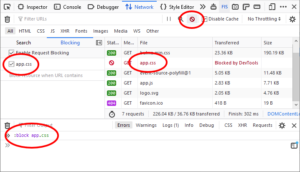
Friends of the Firefox team
Resolved bugs (excluding employees)
Fixed more than one bug
- Andrew Park
- Itiel
- kenrick95
- Sonia
New contributors (🌟 = first patch)
- Andrew Park made sure we don’t report NaN for an add-on download speed.
- Andrew Park also fixed malformed URLs in the bookmarks folder.
- Harsh improved our error logging in the internal Download API.
-
🌟DH Kim made the style of the disabled-paused button clearer
- 🌟Kanishk removed test cases from SearchService.idl
- Kyle Knaggs ensured the context menu items in the Editor copy the expected text to the clipboard
- Stanislav Goncharov made sure the autocomplete list events are not propogated to filter input
- 🌟Anwesha made nodeFront calls smarter
Project Updates
Add-ons / Web Extensions
Addon Manager & about:addons
- Share fixed a couple of issues that were preventing addons from being installed or updated when the builtin cert was not being used (which is the case for some organizations that use their own certificates, or because of some antivirus that install its own certificate to inspect HTTPS connections) – Bug 1647360 and Bug 1648815
- Will Durand made sure that the sourceURL in the addon abuse reports submitted by users will be set to the expected source url even when the website did change it using the history API – Bug 1648036
- Andrew Park contributed a fix that prevents the addon download doorhanger to show “NaN bytes/sec” when the download starts – Bug 1544570
WebExtensions Framework
- Agi fixed a perf issue related to main thread I/O on startup when the rkv-based ExtensionPermissions backend is in use (only Nightly at the moment) – Bug 1651628 (main thread I/O originally introduced in Bug 1637680)
- Landed an initial part of the changes needed to support Extension’s service workers and the manifest v3 background service workers (locked behind prefs “extensions.backgroundServiceWorker.enabled” and “extensions.service_worker_register.allowed”, currently both false by default on all channels) – Bug 1609920 (as a side note: even when enabled using the supported prefs no WebExtensions API are yet available in the Extension’s service workers)
WebExtension APIs
- Rob fixed the validation of the chrome_settings_override’s search_url/suggest_url/search_form, which was allowing more than just localhost urls in those manifest properties – Bug 1651665 (landed in 80 and pending an uplift request to 79, where the originally regression landed, Bug 1612013)
- Harsh Arora contributed a small fix to ensure that the downloads.download API is going to log in the BrowserConsole unexpected errors raised internally when a download fails – Bug 1645337 (originally regressed by Bug 1576333)
Applications
Push
- We’ve identified a reliability issue with Send Tab. The fix is in review now, and will be likely deployed with the 7/28 release.
Developer Tools
-
Layout & Mobile Tools – XPath search now supports more expressions—previously, only expressions starting with a “/” were recognized.
- Check this bug for more details (thanks to Sebo!)
- Infrastructure improvements
Fission
- Making progress with a unified Resource layer. Good progress on DevTools client side and starting also with the backend (server side).
- Individual DevTools panels/tools “watch” for specific resource types (console message, network request, debugger source, etc.) and get them from all debugged scopes automatically (content & main processes, workers, etc.)
Password Manager
- Show/adjust the dismissed login capture doorhanger in response to input events in the password & username field
- Thanks to Kenrick for fixing a number of about:logins issues!
Performance
- Gijs built this really cool Treemap visualization to get a sense of the distribution of DOM nodes in browser.xhtml
- (Right-click zooms out)
- #mainPopupSet is pretty big! That’s why we’re boiling down the panels.
- emalysz is putting together a patch that will help us defer more work to after the initial about:home has painted
- Gijs and emalysz made more of our panels lazier to reduce the initial size of the browser.xhtml DOM
-
Gijs landed a new test to measure how many DOM nodes are in the initial browser.xhtml document to help track fluctuations and prevent bloat
- This is a new kind of performance test – mozperftest.
- Gijs is chasing down a ts_paint_webext regression
- bigiri and Gijs are working on improving our slow script notification experience, starting with measurement
- dthayer advanced Nightly to Stage 3 of FastShutdown!
- dthayer made it so that we cache more things in startupcache – this should have a really nice impact on Beta and Release
- Less of an impact on Nightly because the startupcache is invalidated when the buildIDs get bumped, which is twice daily for Nightly
Picture-in-Picture
- Planning has begun to do some experiments regarding improved discoverability of the Picture-in-Picture toggle
User Journey
- Launched about:welcome experiment in 78 with 2 screens (welcome and import)
- Also testing new Amplitude integration and comparing with Redash
- Adding additional experimental welcome screens for privacy and themes
- Preparing some new default 80 welcome experience based on multistage findings
- Turning on password import autocomplete suggestions by default in 80 with additional robustness over 77 experiment functionality (accessibility, localization)
WebRTC UI
- The goal is to ship the new indicator with DOM notification silencing in Firefox 80. Found any bugs? Here’s a form to file bugs in the right spot.
- Fixed
- In Progress
Repairing my Bose Headphones
Eight years ago I bought a pair of Bose AE2i headphones, for $169. At $169 they weren’t cheap disposable headphones, but they also weren’t high-end the higher-end $400 Bose QuietComfort either.
They have been in daily office use ever since, both for listening to music and for use on video conference calls (as they have a built-in mic, not an amazing mic, but enough).
Over the years the ear pads have gradually disintegrated, until what I was wearing for this morning’s weekly call with Yankee colleagues looked like this:

While the ear pads were wasting away to nothing, everything else was working fine, so I went looking for replacement ear pads, eventually opting to spend $17 on this aftermarket pair on Amazon. They arrived yesterday and I installed them today: kudos to Bose for making headphones that are easily repairable, as the old ear pads popped out and the new ones popped in very easily.

The new ear pads have the added bonus of coming with big “R” and “L” prints to stick on the inside, making it really easy to know which way to put the phones on.
Cycling with Other People
At this week’s meeting of the Mayor’s Task Force on Active Transportation we heard from local resident and active cyclist David Sims about his ideas for active transportation in the city (you can watch the recording of David’s presentation here).
One of the items David touched on was the possibility of enhancing the cycling opportunities in Victoria Park, and he invited Mayor Brown, who attended the meeting, to join him for a cycle through the park this afternoon, and the Mayor extended the invitation to anyone else who wanted to join.
Which is how I found myself on my bicycle with Mayor Brown, David Sims, Mitch Underhay (from Bike Friendly Charlottetown) and Ramona Doyle (Manager of Environment and Sustainability), riding through Victoria Park:

We stopped at several junctures and had good conversations about the park, and about cycling in the city in general. It turns out there’s no better way to talk about the possibilities of cycling than while cycling. Beyond having the evidence in front of us, there’s a certain collegiality it affords.
More than that, though, I got to experience what it was like to cycle as part of a group: it turns out to be lots of fun, and something I think I’d like to do more of. Not “let’s ride to North Cape and have a glass of water” cycling, but “let’s ride out the trail to Royalty Junction and have a picnic” cycling. Now I just need to find other lackadaisical cyclists.
HTTP/3 Is Coming QUIC, Here’s What You Need to Know
For the most part you won't have to do anything in response to this basic upgrade of the underlying protocols all web pages use, though if you manage your own web server you'll have to update it when the new version comes out. QUIC is not officially an acronym, though if you want you can think of it as "Quick UDP Internet Connections". It "replaces TCP at the transport layer and cuts down on the number of round trips a client must make to establish a connection." So it should speed up web connections generally. This is a good overview article, but like I say, you probably won't have to do anything.
Web: [Direct Link] [This Post]Twitter Favorites: [yoshikischmitz] When you stop walking, it starts recording what you say, so you can speak back and take notes.
When you stop walking, it starts recording what you say, so you can speak back and take notes.
Twitter Favorites: [NewsBlur] Introducing highlights and private notes on saved stories. https://t.co/Uc4yQpYDjp https://t.co/nsEfOXXu53
Introducing highlights and private notes on saved stories. blog.newsblur.com/post/623902516… pic.twitter.com/nsEfOXXu53

Twitter Favorites: [samuelclay] NewsBlur is becoming the research tool I wish I had in grad school. https://t.co/ACb25D4FjM
NewsBlur is becoming the research tool I wish I had in grad school. twitter.com/NewsBlur/statu…
Recommended on Medium: Routine, mon amie

Je réfléchis beaucoup à la routine, ces temps. Et je fais ma vaisselle. Ceux d’entre vous qui me lisez depuis des années (des décennies pour certains! mon dieu, j’ai laissé passer sans mot dire les 20 ans de CTTS, il y a 4 jours! va pas falloir que je me rate en 2030, dites donc…) savez que la vaisselle, c’est un thème récurrent chez moi. Comment la faire, ce qu’elle signifie quand elle n’est pas faite, une pointe d’iceberg “indicateur” de plein d’autres choses dans ma vie, débordant plus ou moins de l’évier.
Donc, je réfléchis à la routine, et ma vaisselle est sous contrôle, pour la première fois depuis des années. Ma vie aussi, dans l’ensemble — je crois que la dernière fois que je me suis sentie aussi “on top of things” de façon générale, ça devait être en 2009. (De mémoire.)
Ma tendance naturelle est de fuir la routine, dans laquelle j’ai peur de m’enliser. Du coup je recherche plutôt la nouveauté, l’excitation, l’imprévu, la spontanéité. Adolescente, ma vie était remplie et programmée. Sauf l’été, souvent long et vide (en-dehors des vacances en famille, toujours de bons souvenirs) et dans lequel je finissais par m’ennuyer à déprimer. Du coup, je pense que remplir ça me convenait bien. Jusqu’à ce que je finisse par craquer un peu, et à un moment donné, jeune adulte, j’ai plus ou moins tout envoyé valser, pour être libre, ouverte à l’imprévu, spontanée. Mais bon, ça ne m’avait pas empêcher de prendre plus de 30 périodes de cours durant ma première année de Lettres. On ne se refait pas.
Je pense que mon année en Inde a fini par sceller le sort de ma déstructuration du temps. Là-bas, il vaut mieux ne pas trop s’organiser, si on ne veut pas péter un câble. Ni faire trop. De retour en Suisse, j’étais devenue incapable d’être à l’heure. Je me suis ressaisie, évidemment (le sang de la Vallée de Joux coule dans mes veines, tout de même), mais je suis restée la reine du plan last-minute et de l’improvisation. Le rythme de vie suisse m’a rattrapée, je recommencer à remplir mon agenda, mais durant la longue décennie que j’ai passée à mon compte, j’ai vécu une vie sans beaucoup de rythme. Ou alors, si on veut, au rythme changeant et imprévisible.
Je savais bien que j’avais besoin d’un peu de régularité et de cadre. Un peu, mais pas trop. J’ai parlé de ça ici, au fil des années, mais j’avoue avoir la flemme de déterrer les articles. N’ayant que le peu de contraintes que je m’imposais à moi-même (pas beaucoup), essayant de suivre mes humeurs et mes envies (après tout, j’étais à mon compte pour “faire ce que j’aime”), je me suis quand même vite trouvé avec un problème de procrastination exacerbé (pas nouveau dans ma vie, mais il a bien poussé durant cette période) et une incapacité à poursuivre beaucoup de projets et d’envie personnels parce que… je n’arrivais pas. Je voyais bien que quand j’étais plus occupée, je me sentais mieux, et entre autres choses, un élément qui m’a poussée à redevenir salariée après des années d’indépendance était le besoin de soulager un peu ma charge mentale en passant à un mode de vie où une partie du cadre me serait donné d’office. Et d’ailleurs, ça a marché.
Ces derniers mois, j’ai fait des petites révolutions dans ma vie et ma façon de fonctionner au quotidien. J’ai réalisé (mais vraiment, profondément réalisé) que je pouvais faire des choses parce que j’avais décidé de les faire. Cela peut paraître bête, mais c’était toujours un gros problème pour moi. Je me disais “demain je fais x”, et le moment venu, je n’avais pas envie, ou pas le moral, ou mieux à faire, et j’envoyais balader. Du coup j’ai fini par construire une image de moi-même où j’étais incapable de me “discipliner”, ou de tenir mes engagements vis-à-vis de moi-même. Pour quelqu’un d’autre, aucun problème! Mais pour moi… aïe aïe aïe.
En fait, j’ai compris que si je ne voulais plus courir et vivre à l’arrache, si je ne voulais plus passer des jours et des semaines à culpabiliser parce que je procrastinais, je pouvais faire deux chose: m’organiser (être proactive) et mettre en place des routines et habitudes, pour diminuer la nécessité de décider. Il y a eu un déclic, parlant avec une copine, qui m’a fait réaliser que les personnes “disciplinées” ne l’étaient peut-être pas naturellement, comme ça, sans effort, mais qu’elles se tenaient à leurs décisions ou leur organisation car elles savaient que c’était nécessaire pour leur équilibre ou leur bien-être. Ça a été une révélation pour moi. Ça a été une révélation pour moi.
Ça ne s’est pas mis en place tout de suite, il a fallu entraîner et consolider (je consolide encore). Le premier pas, ça a été de décider chaque jour d’une chose que j’allais faire le lendemain, prise sur ma liste de tâches en souffrance. Des petites choses. Et je me suis retrouvée dans cette situation étrange de n’avoir pas fait la chose en question arrivé le soir, et de me dire “ah, mais j’ai décidé que je le faisais, alors je vais le faire maintenant”. Alors qu’il y a encore quelques mois j’aurais dit “mince, encore une fois je ne l’ai pas fait”. Au niveau de ma planification de tâches au jour le jour, ça m’a fait passer de “liste des choses que je veux/dois/espère/pense que je devrais arriver à faire aujourd’hui” à “petit nombre de choses que je peux garantir que je vais faire”. En quelques jours, au lieu d’être en échec constant, j’ai commencé à prendre confiance et me sentir beaucoup mieux.
La routine, c’est quelque chose qui est sur mon radar depuis FlyLady. Là, ça s’est mis en place un peu tout seul, progressivement. Déjà, mettre un réveil le matin (chose que je fais assez naturellement, même si je me réveille généralement avant). Aller me coucher à une heure raisonnable (l’objet d’un autre article). Me lever, faire le lit, médics des chats, les miens, déjeuner sur le balcon, etc. Le contenu n’est pas important. C’est l’existence de la structure qui compte.
Ma tentation naturelle, ça a été de vouloir tout “routinifier”. D’organiser ma semaine à coups de “lundi je fais ça, mardi je fais ça, mercredi, jeudi, vendredi”. Et j’ai compris qu’il fallait y aller progressivement. Parce que l’autre Grande Mission de cette année 2020, pour moi, c’est d’apprendre à mettre un peu plus la priorité sur moi et mes besoins. Pas difficile de faire plus que quasi rien, me direz-vous. A force de mettre les besoins des autres toujours avant les siens, on finit par disparaître. Donc: structurer une partie de mon temps tout en gardant une large part “pour moi”. Le Chemin du Milieu est rarement facile à trouver, mais là, je trouve que je ne m’en sors pas trop mal.
J’ai commencé par poser une chose dans ma semaine. Deux heures de temps, dans l’agenda, pour m’occuper d’un projet. La même plage horaire, le même jour, chaque semaine. Et m’y tenir! Maintenant que j’ai un peu pris l’habitude, ça va, mais au début ce n’était pas évident. J’étais toujours tentée de déplacer/annuler/déprioriser pour autre chose. Et j’ai fait plusieurs semaines comme ça, avec juste une chose dans l’agenda, avant de progressivement, petit à petit, rajouter d’autres éléments pour structurer ma semaine. Il faut dire qu’après six mois de chômage (où je n’étais pas en très bon état dans ma tête, pour tout un tas de raisons — j’ai peut-être mentionné que j’avais eu une année ou deux de merde?) suivis par six mois d’incapacité de travail post-op, on ne peut pas reprendre du jour au lendemain un rythme effréné. Surtout si le but est de construire un nouvel équilibre, un peu plus durable.
Du coup, j’ai de la routine: dans ma journée, dans ma semaine. J’avoue que ça m’émerveille. Parce qu’elle ne tient qu’à moi, mais que je m’y tiens néanmoins. Quand je vacille, c’est quelque chose auquel je peux me raccrocher. Et que je cherche à ne pas lâcher dans les périodes où je ne vacille pas (la tentation est grande). Le “confinement” (à la suisse) est arrivé à pic, pour moi: il m’a permis de prendre goût à me donner plus de place.
Je pense que notre rapport à la routine, à la structure, à l’organisation, ça dépend beaucoup de notre personnalité et de notre parcours de vie personnel. Il y a des gens qui sont emprisonnés dans des habitudes et un quotidien dont ils ont désespérément besoin de sortir; d’autres qui se recroquevillent sur la répétition et le contrôle; d’autres encore qui sont allergiques à tout ce qui pourrait les contraindre de près ou de loin, et se perdent. Je pense que souvent, c’est multi-couches. Comme moi, qui suis tiraillée entre une envie d’ordre parfait et une autre de liberté absolue.
Quelque part au milieu, il y a la sérénité. Relative.
Originally published at Climb to the Stars.
Safari Tabs Are Weird
Recently I switched from Chrome to Safari because on a 2019 16" MacBook Pro, Chrome has nasty video glitches; apparently Apple and Google are blaming each other for the problem. My first impression of Safari is decent, subjectively it feels faster than Chrome. But browser tabs act in ways that that feel somewhere between “weird” and “badly broken”. Here are a few of the issues I’ve encountered.
[Update: Lots of free wisdom on offer in the comments here, including some that improved my life.]
Tab display
On Chrome, if you have a lot of tabs — I typically have 20 or 30 open — they get narrower and narrower and until completely crushed out of existence show a little glimpse of icon and label, so you can find what you’re looking for.
On Safari, the tabs near the one you’re on are shown pretty well full-width with quite a bit of white-space surrounding labels and icons (where by “white ” I mean “grey”). You can two-finger drag the tab label array right and left and they shuffle around in a graceful way.
I don’t like this because I lost all-my-tabs-at-a-glance. If you have hundreds open I guess that wouldn’t work anyhow.
But I do like it because when I’m looking for a tab that’s not obvious to the eye, it’s easier to find. Hmm, I’ll call this a saw-off.
Tab pinning
All the browsers support tab pinning these days, which is great because it enables the Mighty Tab Trick, where you park the eight tabs you use all the time and insta-hop to them using CMD-1 through CMD-8.
But Safari pins tabs hard. If you follow a link off the site you’re at, new tab. If you go somewhere, pin it, then press Back, new tab. You can’t nuke the tab with CMD-W. I mean it’s not pinned, it’s nailed the fuck down.
This can lead to weirdly buggy behavior, which this blog provokes. If you’re reading this in a web browser, there’s a search field up the top right which does a dumb simple Google search of the blog. Now, I keep ongoing in a pinned tab for obvious reasons. If I a do a search, the blog is replaced by a Google search output page. Fine. But that page now exhibits hard-pinning. If I click a result, that opens in a new tab. If I press back, it opens my blog… in a new tab. In fact there is absolutely no way back to the blog from the search result page. I think I’d call this a bug?
Left and right
[Update: Check the comments for better options. I think I withdraw this complaint.]
You can move from any tab to the next one on the left or right. The key combo is CMD-Shift-left/right, annoyingly different from other browsers. But a lot of the time it just doesn’t work. If you’re in a form, or a text-edit field, or really any mode that you might be able to interact with what’s in the tab, you can’t step left or right.
I often put a couple of tabs next to each deliberately, like when I’m editing a Wiki page and I have supporting evidence I need to copy from, if it’s in the next tab it’s easy to flip back and forth. But impossible on Safari because if you can edit, you can’t flip.
This one really feels like a bug. Or am I weird?
Where do new tabs go?
[Update: “Debug” menu suggestion below: Verified; note that you have to click several things in that sub-sub-menu.]
I mean tabs that are opened because the link requested it, like from a search-results page or, as described above, a pinned tab, not because you hit CMD-T to ask for one. Safari is consistent with Chrome on this one, which is a pity, because they’re both wrong, they both open the new tab as close as possible to where you are. Which, if in you’re in the middle of a bunch of pinned tabs, is not what you’d expect.
I’d actually like it if all new tabs opened over at the right end of the row. At least as a settings option. Because then you’re tabs would naturally arrive at a structure of the oldest ones being at the left and the newest ones to the right. I can see room for argument about this, but I suspect the current policy was arrived at before a lot of people had many pinned tabs, because that’s where the behavior becomes confusing.
Did I miss any?
I wish everything worked the same.
My experience in Updating to Thunderbird 78
Another good find by Neil Mather for me to read...
Another good find by Neil Mather for me to read a few times more. A first reaction I have is that in my mind p2p networks weren’t primarily about evading surveillance, evading copyright, or maintaining anonymity, but one of netwerk-resilience and not having someone with power over the ‘off-switch’ for the entire network. These days surveillance and anonymity are more important, and should gain more attention in the design stage.
I find it slightly odd that the dark web and e.g. TOR aren’t mentioned in any meaningful way in the article.
Another element I find odd is how the author talks about extremists using federated tools “Can or should a federated network accept ideologies that are antithetical to its organic politics? Regardless of the answer, it is alarming that the community and its protocol leadership could both be motivated by a distrust of centralised social media, and be blindsided by a situation that was inevitable given the common ground found between ideologies that had been forced from popular platforms one way or another.”
It ignores that with going the federated route extremists loose two things they enjoyed on centralised platforms: amplification and being linked to the mainstream. In a federated setting I with my personal instance, and any other instance decides themselves whom to federate with or not. There’s nothing for ‘a federated network to accept’, each instance does their own acceptance. There’s no algorithmic rage-engine to amplify the extreme. There’s no standpoint for ‘the federated network’ to take, just nodes doing their own thing. Power at the edges.
Also I think that some of the vulnerabilities and attack surfaces listed (Napster, Pirate Bay) build on the single aspect in that context that still had a centralised nature. That still held some power in a center.
Otherwise good read, with good points made that I want to revisit and think through more.
Bookmarked This is Fine: Optimism & Emergency in the P2P Network...driven by the desire for platform commons and community self-determination. These are goals that are fundamentally at odds with – and a response to – the incumbent platforms of social media, music and movie distribution and data storage. As we enter the 2020s, centralised power and decentralised communities are on the verge of outright conflict for the control of the digital public space. The resilience of centralised networks and the political organisation of their owners remains significantly underestimated by protocol activists. At the same time, the decentralised networks and the communities they serve have never been more vulnerable. The peer-to-peer community is dangerously unprepared for a crisis-fuelled future that has very suddenly arrived at their door.
Dreaming in Git
I recently read a Five Books interview about the best books on philosophical wonder. One of the books recommended by philosopher Eric Schwitzgebel was Diaspora, a science fiction novel by Greg Egan I've never read. The story unfolds in a world where people are able to destroy their physical bodies to upload themselves into computers. Unsurprisingly, this leads to some fascinating philosophical possibilities:
Well, for one thing you could duplicate yourself. You could back yourself up. Multiple times.
And then have divergent lives, as it were, in parallel but diverging.
Yes, and then there'd be the question, "do you want to merge back together with the person you diverged from?"
Egan wrote Diaspora before the heyday of distributed version control, before darcs and mercurial and git. With distributed VCS, a person could checkout a new personality, or change branches and be a different person every day. We could run diffs to figure out what makes one version of a self so different from another. If things start going too wrong, we could always revert to an earlier version of ourselves and try again. And all of this could happen with copies of the software -- ourselves -- running in parallel somewhere in the world.
And then there's Git. Imagine writing such a story now, with Git's complex model of versioning and prodigious set of commands and flags. Not only could people branch and merge, checkout and diff... A person could try something new without ever committing changes to the repository. We'd have to figure out what it means to push origin or reset --hard HEAD. We'd be able to rewrite history by rebasing, amending, and squashing. A Git guru can surely explain why we'd need to --force-with-lease or --unset-upstream, but even I can imagine the delightful possibilities of git stash in my personal improvement plan.
Perhaps the final complication in our novel would involve a merge so complex that we need a third-party diff tool to help us put our desired self back together. Alas, a Python library or Ruby gem required by the tool has gone stale and breaks an upgrade. Our hero must find a solution somewhere in her tree of blobs, or be doomed to live a forever splintered life.
If you ever see a book named Dreaming in Git or Bug Report on an airport bookstore's shelves, take a look. Perhaps I will have written the first of my Git fantasies.
Thoughts on inclusion, diversity, and anti racism in Kamloops...
-
Engage and educate each other: I don’t see a lot of success in the call out culture on an individual level. Yes, we must let people know when we feel they are being racist and / or discriminatory. This may stop the behaviour. But I am not sure it changes the views. This take fostering understanding and relations between different people with different backgrounds. This takes being empathetic to each other. If I say to someone “you are an awful racist”, I am not sure they will immediately agree and change. Their response seems more likely to be “no I am definitely not” and then the walls get built higher against any progress. Can we be empathetic to those who hold racist or discriminatory views? Where would we draw the line here? To me, these are important and interesting questions. I would potentially propose here facilitating public and private conversations between people of different backgrounds to build goodwill and understanding.
-
City council, city staff, the RCMP, and the Fire service should learn more about diversity, inclusion, and racism: City council has taken Indigenous Awareness training and regularly meets with T’kemlups Te Secwepemc colleagues and friends. I think it would be good to broaden this training to better understand the further diversity of the citizens we serve. This is more for me about being more aware of unconscious racism and discrimination and of systemic bias in practices and processes. And also, it makes it much less hospitable for any overt and conscious discrimination to occur. This training should be mandatory.
-
City hall should continue to build a diverse and inclusive workforce: From time to time, I field concerns that the city workforce does not represent the diversity of Kamloops. I am confident that there is no overt discrimination in city hiring practices and have worked with many people from diverse backgrounds all over city operations. The city does not have hiring quotas and I support an open hiring practice. I’d like to know more about efforts the city can make to outreach to communities that might have some barriers in easily accessing job opportunities. I think we need to ensure all citizens understand how city hiring practices are conducted. And I’d like to know how we are looking at unconscious bias and systemic racism and what we will do to eliminate these if they exist. And we need to be open to good faith feedback on how we can be more inclusive in hiring.
-
Remain open to ways to do better: This is tough and it will take time. But it has potential to be transformational. I think its so important to stay open minded to changes and not to get complacent with the first or second thing we undertake.
Bitcoin scam, Twitter hacked
Twitter was hacked yesterday. Over a few hours, prominent accounts were tweeting that they were feeling generous during these times, and that if you sent them Bitcoin, they would send double the amount back. For The New York Times, Matthew Conlen and Lazaro Gamio show the Bitcoin scammed as more tweets flowed in.
Tags: Bitcoin, hack, New York Times, Twitter
Firefox Nightly supports TWA-based web apps from the Play Store

Firefox on Android can now work with Trusted Web Activities, something previously only available through Google Chrome and other Chromium browsers.
Trusted Web Activities (TWAs) are essentially websites or web apps that run in a modified Chrome Custom Tab. TWAs exist as one of Google’s many options for app developers opening web content within apps.
Typically when users open web content from an app, one of a few things will happen. Either the link opens in the default browser, it can open the content in WebView, an embedded, sandboxed and limited option, or a Custom Tab. TWAs mostly operate as a version of Custom Tabs that don’t display any user interface (UI) and have some extra restrictions developers must adhere to.
Alternatively, some Play Store applications operate as web apps running inside TWAs, almost like a Progressive Web App (PWA) with extra steps. Android Police notes that Google Maps Go and PhotoStack are examples of TWA-based apps you can install from the Play Store.
These apps previously only worked with Chrome, which meant even if you had a different default browser, they would still use Chrome or a Chromium-based browser. Now Firefox Nightly supports TWAs and can run them instead of Chrome.
Unfortunately, the support isn’t perfect. It should come as no surprise given that Firefox Nightly often contains bugs. Android Police reports that some TWA apps work, but Firefox doesn’t hide the browser UI. The point of TWAs is to hide the browser UI for a more seamless experience.
Other TWAs, like Google Maps Go, have built-in checks that look for Chrome and prevent the TWA app from working on other browsers.
Of course, Firefox Nightly still represents Mozilla’s early efforts in supporting TWAs. That said, TWA support has been live in Nightly for a while now. Hopefully Mozilla can iron out the kinks before TWA support moves to Firefox Beta, which should happen soon.
Source: Android Police
The post Firefox Nightly supports TWA-based web apps from the Play Store appeared first on MobileSyrup.
People literally don't see things the same way
The headline is overstated, but the details in this short article are no less interesting for it. In a nutshell, people differ in the way they place objects in their field of vision. "For example, when glancing at a coffee cup on a table, can two people agree on its exact position and whether its handle is big enough to grip? The result of a series of experiments suggest not." Each person, suggests the article, "has a unique visual fingerprint." Here's the full study from the Royal Society.
Web: [Direct Link] [This Post]The evolution of the global education industry during the pandemic
It's not clear whether the authors of this report are opposed to the use of technology in education or the commercialization of education, and maybe it ultimately doesn't matter because the one is consistently conflated with the other throughout this report. Yes, there was a lot of ed tech used during the pandemic, and that's because the non-tech alternative of breathing in each others' faces wasn't available. From where I sit, the variuous organizations, institutions and companies involved have been responding to the general failure of traditional educational institutions, and their professors, to provide any meaningful response either to the pandemic, to cost considerations and chronic inequality, and to contemporary learning needs. I am a greater supporter of public education than most, and I am distressed that the intransigence of academia has pushed us to this point. (78 page user-hostile Issuu format).
Web: [Direct Link] [This Post]The Smartass Manifesto
I’m a smartass. That’s my brand. I might as well admit it. What does that mean? It means that in any given situation — meeting, client interaction, blog post, reaction to news, Facebook post, romantic date — my mind immediately tries to find a unique, snarky, counterintuitive take. The ultimate smartass remark, intended to get … Continued
The post The Smartass Manifesto appeared first on without bullshit.
HyperX Quadcast :: Ein gutes und preiswertes USB-Kondensatormikrofon

Zwei Pakete kamen heute. In einem war das großartige HyperX Quadcast USB-Mikrofon, in dem anderen die Neewer Lightbox, in dem dieses Foto entstand. Aber erst mal der Reihe nach.

Ich trage aktuell zwei Headsets: Surface Headphone für alles von Musik über Videos bis zu Conference Calls. Und noch lieber das wunderbare Shure Aonic 50, das ich bereits besprochen habe. Das kann alles besser, außer Tonaufnahmen. Die Musterlösung wäre ein Shure SM7B mit einem Audio-Interface. Aber das war dann doch eine Nummer zu dick.
Sehr viel einfacher ist das Rode NT-USB. Und über das kam ich dann zu diesem HyperX QuadCast. Klanglich und von der Funktion her sind die beiden vergleichbar, beides USB-Kondensatormikrofone mit Tischstativ und Popschutz. Beim Rode hängt er davor, beim HyperX ist er eingebaut. Beide haben einen Kopfhörerausgang, aber das Quadcast hat vier Funktionen, die ich ziemlich cool finde:
- Wenn das Quadcast eingeschaltet ist, dann leuchtet es rot. Das entspricht dem Busylight der Jabra Headsets. Bei einem Videocall ist sofort klar, wann man etwas sagen will.
- Tippt man oben auf das Mikrofon, wird es stummgeschaltet und das rote Licht geht aus. Beim nächsten Tippen ist es wieder eingeschaltet und das Licht geht an. Das ist sehr intuitiv und man weiß stets, in welchem Zustand man ist.
- Unter dem HyperX-Schriftzug ist ein Drehregler, mit dem man den Pegel einstellen kann. Das ist sinnvoll, wenn man mal näher am Mikrofon und mal weiter weg ist.
- Das Quadcast hat vier Mikrofoncharacteristiken: Stereo, Kugel, Niere, Acht. Stereo ist klar, Kugel heißt, dass der Schall von allen Seiten gleich aufgenommen wird, Niere dämpft alles, was nicht von vorne kommt. Acht schließlich nimmt von vorne und hinten auf, dämpft aber die Seiten.
Das Einzige, was dem Mikro fehlt, ist ein Lautstärkeregler für den Kopfhörerausgang. In der Praxis ist das für mich irrelevant, weil ich diesen Pegel am PC einstelle.
Twitter Favorites: [DenimAndSteel] Friend at Twitter engineering sent ominous news: the blue checkmark accounts can be saved but they’ll never be the… https://t.co/DpbQpL8wEI
Friend at Twitter engineering sent ominous news: the blue checkmark accounts can be saved but they’ll never be the… twitter.com/i/web/status/1…
Develomentor podcast: Simon Willison – Data Journalism, The Importance of Side Projects
Develomentor podcast: Simon Willison – Data Journalism, The Importance of Side Projects
Grant Ingersoll interviewed me for the Develomentor podcast. We talked about my career so far, and how much of it was driven by side-projects that I've worked on individually or with Natalie.
Via @develomentor
Weeknotes: datasette-auth-passwords, a Datasette logo and a whole lot more
All sorts of project updates this week.
datasette-auth-passwords
Datasette 0.44 added authentication support as a core concept, but left the actual implementation details up to the plugins.
I released datasette-auth-passwords on Monday. It's an implementation of the most obvious form of authentication (as opposed to GitHub SSO or bearer tokens or existing domain cookies): usernames and passwords, typed into a form.
Implementing passwords responsibly is actually pretty tricky, due to the need to effectively hash them. After some research I ended up mostly copying how Django does it (never a bad approach): I'm using 260,000 salted pbkdf2_hmac iterations, taking advantage of the Python standard library. I wrote this up in a TIL.
The plugin currently only supports hard-coded password hashes that are fed to Datasette via an environment variable - enough to set up a password-protected Datasette instance with a couple of users, but not really good for anything more complex than that. I have an open issue for implementing database-backed password accounts, although again the big challenge is figuring out how to responsible store those password hashes.
I've set up a live demo of the password plugin at datasette-auth-passwords-demo.datasette.io - you can sign into it to reveal a private database that's only available to authenticated users.
Datasette website and logo
I'm finally making good progress on a website for Datasette. As part of that I've been learning to use Figma, which I used to create a Datasette logo.
Figma is really neat: it's an entirely web-based vector image editor, aimed at supporting the kind of design work that goes into websites and apps. It has full collaborative editing for teams but it's free for single users. Most importantly it has extremely competent SVG exports.
I've added the logo to the latest version of the Datasette docs, and I have an open pull request to sphinx_rtd_theme to add support for setting a custom link target on the logo so I can link back to the rest of the official site, when it goes live.
TIL search snippet highlighting
My TIL site has a search engine, but it didn't do snippet highlighting. I reused the pattern I described in Fast Autocomplete Search for Your Website - implemented server-side rather than client-side this time - to add that functionality. The implementation is here - here's a demo of it in action.
SRCCON schedule
I'm attending (virtually) the SRCCON 2020 journalism conference this week, and Datasette is part of the Projects, Products, & Research track.
As a demo, I set up a Datasette powered copy of the conference schedule at srccon-2020.datasette.io - it's running the datasette-ics plugin which means it can provide a URL that can be subscribed to in Google or Apple Calendar.
The site runs out of the simonw/srccon-2020-datasette repository, which uses a GitHub Action to download the schedule JSON, modify it a little (mainly to turn the start and end dates into ISO datestamps), save it to a SQLite database with sqlite-utils and publish it to Vercel.
Covid 19 population data
My Covid-19 tracker publishes updated numbers of cases and deaths from the New York Times, the LA Times and Johns Hopkins university on an hourly basis.
One thing that was missing was county population data. US counties are identified in the data by their FIPS codes, which offers a mechanism for joining against population estimates pulled from the US Census.
Thanks to Aaron King I've now incorporated that data into the site, as a new us_census_county_populations_2019 table.
I used that data to define a SQL view - latest_ny_times_counties_with_populations - which shows the latest New York Times county data with new derived cases_per_million and deaths_per_million columns.
Tweaks to this blog
For many years this blog's main content has sat on the left of the page - which looks increasingly strange as screens get wider and wider. As of this commit the main layout is centered, which I think looks much nicer.
I also ran a data migration to fix some old internal links.
Miscellaneous
I gave a (virtual) talk at Django London on Monday about Datasette. I've taken to sharing a Google Doc for this kind of talk, which I prepare before the talk with notes and then update afterwards to reflect additional material from the Q&A. Here's the document from Monday's talk.
San Francisco Public Works maintain a page of tree removal notifications showing trees that are scheduled for removal. I like those trees. They don't provide an archive of notifications from that page, so I've set up a git scraping GitHub repository that scrapes the page daily and maintains a history of its contents in the commit log.
I updated datasette-publish-fly for compatibility with Datasette 0.44 and Python 3.6.
I made a few tweaks to my GitHub profile README, which is now Apache 2 licensed so people know they can adapt it for their own purposes.
I released github-to-sqlite 2.3 with a new option for fetching information for just specific repositories.
The Develomentor podcast published an interview with me about my career, and how it's been mostly defined by side-projects.

